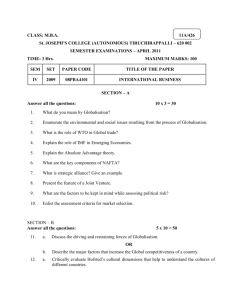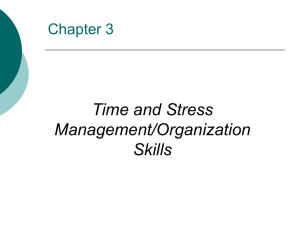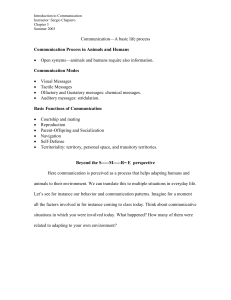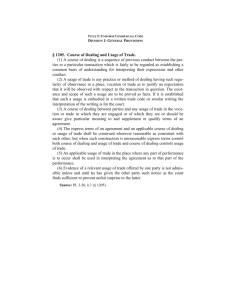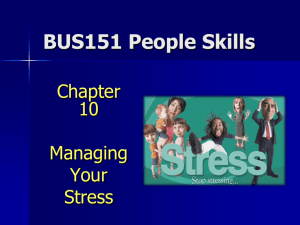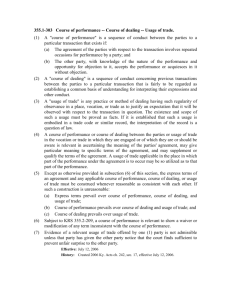Besigheidstudies
advertisement
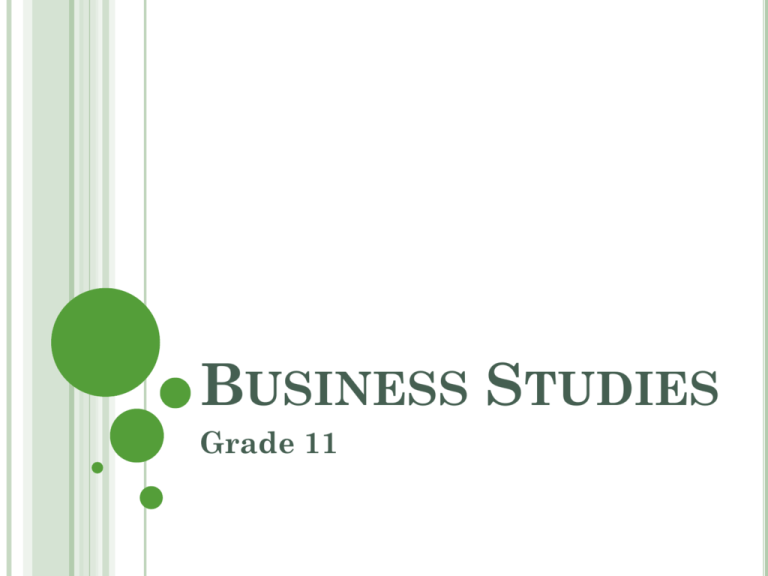
BUSINESS STUDIES Grade 11 TERM 2 Business ventures and Business roles STRESS AND CRISIS MANAGEMENT INTRODUCTION The fast pace at which we are living nowadays and the fast rate at which change is occurring in the business environment, are two major causes of stress. If we do not learn to manage stress, the results can be disastrous for our physical and emotional wellbeing. STRESS MANAGEMENT Stress is our body’s response to difficult situations. 2 kinds of stress: positive stress and negative stress. Positive stress can spur us into action and motivate us to perform. Negative stress is bad for our health and can lead to conditions such as: Sleeplessness Loss of appetite High blood pressure Heart conditions A weakened immune system Ulcers STRESS MANAGEMENT* Categories of stress Career development, status and pay • Having too much or too little to do • Working under time pressure Where the work is done • Job security • Lack of promotion opportunities • Under-promotion and overpromotion • Work of ‘low social value’ • Piece rate payment schemes • Unclear / unfair performance-evaluation systems • Being over-skilled or underskilled for the job. Role in the organisation Job content • Boring and meaningless tasks • Lack of variety • Unpleasant tasks • Dangerous tasks Workload and work pace How the work is done • Unclear role in organogram • Conflicting roles within the same job • Responsibility for people • Always dealing with other people and their problems Categories of stress Interpersonal relationships • Lack of participation in decision-making • Lack of control (for example over work methods, work pace and working hours) Where the work is done • Weak and careless supervision • Bad relations with co-workers • Bullying (forcing someone to do something against their will), harassment and violence • Isolated or solitary (done alone) work • No process to deal with problems or complaints Home Organisational culture versus work Working hours • Strict working schedules • Long hours working alone • Unpredictable working hours • Badly designed shift systems Participa-tion and control How the work is done • Poor communication • Poor leadership • Lack of clarity about the business’ objectives. • Demands of work and home that interfere • No support for home problems at work • No support for work problems at home STRESS MANAGEMENT Stress not only affects our bodies, it also affects our emotions. Stressed people tend to be more emotional and less rational. Means that stressed people sometimes have trouble making good decisions. We cannot eliminate stress from our lives, but we can learn how to cope with it. The following measures can be implemented in your life to help you deal with stress: Prioritise Do not procrastinate Plan our time Follow a balanced diet Get enough sleep STRESS MANAGEMENT Because the corporate environment is so stressful, business enterprises are increasingly realising the importance of stress management. Stress management involves teaching employees to cope with stress and providing facilities to employees to help them reduce stress levels. People who are capable of managing stress will be: • Absent less. • More productive. • Less irritable. • Better able to control their emotions. • More rational. STRESS MANAGEMENT* Strategies to manage stress experienced at work Work-based strategies • • • • • • • • • • • Share the workload differently. Select and train workers properly. Consult workers about working practices. Introduce flexitime. Increase the support workers get. Encourage cooperation and teamwork. Arrange stress-management training (time management, healthy lifestyle). Improve the equipment used and the physical working conditions. Improve managers’ attitudes, knowledge and skills towards dealing with work stress. Implement better work and management systems. Develop a friendly and more supportive culture. Personal strategies • Develop your self-awareness to recognise the signs of stress and its causes. • Create a balanced lifestyle and minimise extreme emotions and chaos. • Exercise regularly and keep fit. • Follow a balanced diet. • Get enough sleep and relaxation. • Replace negative self-talk with positive thoughts. • Stop worrying about things that are beyond your control. THE IMPORTANCE OF STRESS MANAGEMENT IN WORK ENVIRONMENTS Absenteeism: • • • • • Absenteeism is when workers stay away from work. Stressed employees are more likely to miss work, both as a way to cope and due to healthrelated problems. Lost productivity and replacement costs are a consequence of absenteeism. Stress has been identified as the cause of heart attack, stroke and even cancer. Premature death among workers increases staff turnover and requires more regular recruitment and training. THE IMPORTANCE OF STRESS MANAGEMENT IN WORK ENVIRONMENTS Poor • • judgement: Workers who suffer from stress often display poor judgement in crisis or emergency situations. This can lead to a high occurrence of accidents on the factory floor. THE IMPORTANCE OF STRESS MANAGEMENT IN WORK ENVIRONMENTS Grievances or complaints that lead to staff turnover: • • • • • When a business experiences many complaints by workers, it is a sign that something is wrong. Workers who feel powerless and stressed often will file complaints as an attempt to do something about the situation. Unresolved complaints can lead o resignation and higher staff turnover. When a worker resigns, a lot of productive time is lost in the process of recruiting and training new employees. A high staff turnover is also not good for staff morale. THE IMPORTANCE OF STRESS MANAGEMENT IN WORK ENVIRONMENTS Conflict • • • and interpersonal problems: Workers who are already under stress will find it difficult and more stressful to work in teams. Most business in South Africa have diverse work forces and employees are expected to work in teams. The interpersonal demands due to working with team members and supervisors are the most significant cause of burnout. THE IMPORTANCE OF STRESS MANAGEMENT IN WORK ENVIRONMENTS Customer • • • service problems: Having stressed and tired employees serving the public may lead to poor service and unhappy customers. This can have serious effects on turnover and profit. Therefore, even if a small number of customers are not completely satisfied with a business’ service, it can result in a huge loss in profitability. THE IMPORTANCE OF STRESS MANAGEMENT IN WORK ENVIRONMENTS Resistance • • • • to change: Many efforts to change and improve businesses have failed because the employees resisted the change. As a person’s stress level increases, that person is more likely to cling to the old ways of doing things, even if they are no longer effective. Research shows that stress is also connected with neophobia, the fear of new things. As people become more stressed, the new and the different set off fear. CRISIS MANAGEMENT What • • • is a crisis: A crisis is a time of intense difficulty, trouble, or danger. A business-related crises is any event that can, within a short period of time, harm the business’ stakeholders, its property, finances or its reputation. Depending on a business’ specific circumstances, there are many possible events that might be considered a crises: CRISIS MANAGEMENT Examples: Natural disasters such as earthquakes, wind damage and flooding caused by heavy rain can prevent the business form functioning properly. Theft or vandalism to vital equipment can stop production. The equipment will be costly to replace and its loss may even pose health and safety risks. Fire can be accidental (an electrical fault) or deliberate (arson) and can destroy a business physically. Power outages happen often in South Africa and many businesses have experienced the impact of loss of power on their information technology (IT) and communication systems, key machinery and equipment. IT system failures can happen when hackers, computer viruses or equipment failures damage the system. These failures could affect workers’ ability to work effectively. CRISIS MANAGEMENT Examples: Restricted access to premises will prevent staff members form getting to work. This can happen if the factory plant is closed due to a gas leak, or when striking workers block entrances while protesting. Sudden loss or illness of staff is a crisis for all businesses. Outbreak of a disease of infection among the staff could present serious health and safety risks. Crises affecting suppliers can impact severely on service delivery if alternative suppliers cannot be found. Fuel shortages happen when there are strikes in the oil and petroleum industry or when there is a shortage of oil internationally. These temporary shortages in fuel supply could prevent staff from getting to work and could affect the business’ ability to make and receive deliveries. When products and services are not being delivered to consumers, they must be covered by insurance or customer guarantees. Crisis affecting the business’ reputation will require drastic action to prevent long-term damage, for example in the event of a product recall. CRISIS MANAGEMENT* A crisis is a difficult situation. Stages in a crises Stage 1 Before the crisis At this stage there are very few signs of the crisis. Stage 2 Warning There are clear indications that an event may happen and cause harm to the business. Stage 3 Crisis point The event related to the crisis starts showing harmful effects on the business. Stage 4 Recovery The serious stage of crises has passed and the business is able to focus on a return to normal operations. Stage 5 Post crisis Formally assess the damage caused by the event, start repairing what was damaged and consider a contingency plan to prevent or deal with a similar crisis in the future. CRISIS MANAGEMENT Tips • • • • • on handling a crisis at work: Do not get involved in other people’s crises. Act promptly. Remain calm. If the crisis falls within your field of expertise, act on it. Discuss the crisis with a colleague you trust as this will help you gain perspective. CRISIS MANAGEMENT A crisis can take on many forms. Have a look at ways of dealing with the following situations: Tight deadlines: A deadline is a point in time by which a particular task has to be completed. Careful planning is necessary to avoid a crisis due to missing a deadline. Many people make the mistake of first completing tasks they like and leaving less enjoyable tasks for later. Instead, a person should complete tasks that are due soon first. After these tasks have been completed, tasks with a later due date should be completed. Missing a deadline can make you appear incompetent and unprofessional. CRISIS MANAGEMENT Loss of property of fire: Losing property to fire results in financial losses. Business owners should check that their insurance covers fire damages and that buildings are insured at replacement value. Back-ups of important documents should be made regularly. Stock records should be kept in a fire proof safe. This helps managers determine the exact number of stock that is lost in a fire. These steps will help minimise financial losses and enable business enterprises to recover form damages sooner. CRISIS MANAGEMENT Illness: Each employee brings a unique set of competencies and experience to his/her place of work. If a person gets sick, it means that that person’s tasks remain undone. This is not a crisis if a person is only absent from work for a day or two. It can however become a crisis if a person is seriously ill and has to stop working for a week or more. This is one of the reasons why communication in an enterprise is important, because communication provides important information to colleagues and enables them to temporarily take of over form a sick employee if that becomes necessary. CHANGE MANAGEMENT In a broad sense, change means a planned or unplanned reaction to pressures and forces. In modern times, change has become a powerful issue because pressures happening at the same time are more unpredictable and more extreme. Successful change management is one of the most important management survival skills or this century. In the recent times, life in South Africa has seen much change. In the fast-moving, highly competitive global marketplace, continuous change is required for businesses to remain competitive. Companies that want to be world-class have to adapt to change, be flexible, take the needs of all stakeholders into account, allow employees to be entrepreneurial and reward them according to the contributions they make. CHANGE MANAGEMENT ‘Managing change’ means making changes in a planned and managed manner. These changes are then managed and controlled by the business. A decision to change the management information system (MIS) of the business may be a response to events that happened in the micro or market environments of that business. A second meaning of managing change is responding to changes over which the business has little or no control. External changes are changes beyond the control of a business. These include how to deal with new legislation, political upheaval, upward or downward economic swings and the emergence of communitybased pressure groups. CHANGE MANAGEMENT Change management is designed to bring new life, creativity and innovation to a business. Change often leads to resistance, and employees become pessimistic, cynical and distrusting. It is usually the function of the human resources department to act as mediator, supporting the management team and motivating employees. CHANGE MANAGEMENT Types of change: Change can either be triggered by factors outside the business enterprise (external change), or by factors inside the business enterprise (internal change). External change: • Triggered by factors which are outside the business enterprise’s control. • Usually takes place in reaction to factors such as legislation, the actions of competitors, changing economic conditions or socioeconomic factors, such as HIV/Aids. Internal change: • Aims to address the weaknesses within a business enterprise. CHANGE MANAGEMENT Types of change: Because business enterprises operate in a dynamic environment, change will always be part of business. Business enterprises that resist change do not grow. It is therefore vitally important that business enterprise recognise the need for change and implement change. CHANGE MANAGEMENT Dealing with business-related crises: Dealing with, or managing, a crisis includes the decisions that need to be taken to protect a business from the harmful effects that a crisis may have. This often needs to happen as the crisis is happening, while the management is under stress and still lacks all the information needed to deal with the crisis. The key for managing a crisis is to do as much planning as possible before a crisis starts. This will position the business to respond appropriately and lessen the effects of the crisis situation. Crisis management involves: Identifying a crisis Planning a response to a sudden event that poses a significant threat to the business Limiting the damage Selecting an individual or team to deal with the crisis Resolving the crisis CHANGE MANAGEMENT Theories of change management Change initiates growth Most people have a natural tendency to resist change Everyone should play an active role in the change management process • Business enterprises grow and develop through change. • A business enterprise will therefore strengthen its position in the market through effective change management. • Because change is uncertain, it sometimes causes people to feel insecure during the change management process. • Successful change management depends on management’s ability to motivate the employees to accept the proposed change. • Change management is primarily top management’s job, but all employees contribute to successfully implementing change. • Employees are more likely to accept change if they are given an active and important role in the change management process. CHANGE MANAGEMENT Theories of change management The change should result in tangible and visible benefits • Employees are more likely to accept change if the proposed change will benefit them. • Management should therefore aim to achieve short term results which will benefit employees. Change management is • The business environment changes a continuous process continuously. • A business enterprise without an effective change management policy will not survive the demanding business environment. CHANGE MANAGEMENT* Theories of change management Business process re-engineering (BPR): This theory argues that business processes need to be improved in order to deal effectively with change, even if individuals are motivated and prepared to work hard and deal with change. Business process re-engineering is the concept used to describe the change of processes in the business. The theory proposes that re-engineering the business processes is the key to changing how people work. A small change in processes can have dramatic effects on cash flow, service delivery and customer satisfaction. CHANGE MANAGEMENT Theories of change management Total quality management (TQM): The aim of this change-management theory is to have long-term success of the business through customer satisfaction. In a TQM effort, the management and employees of a business work together to improve processes, products, services and the culture that they work in. The theory is that if all the business processes are done right the first time, it will minimize defects and waste. CHANGE MANAGEMENT Theories of change management Total quality management (TQM): Kaizen model: The Kaizen model is Japanese and means “to become good through change”. The model suggests that a business needs to restructure and reorganize. The Kaizen model is based on the following five elements: Quality groups meet to discuss levels of quality in their divisions. Strong morale among employees is an important principle. Managers must keep in constant contact with employee morale. Teamwork is necessary. Personal discipline of each employee ensures that the team will stay strong. Suggestions for improvement from all employees. This will allow management to address problems before they become significant. CHANGE MANAGEMENT Theories of change management Total quality management (TQM): John Kotter’s change model: John Kotter identified eight steps that need to be taken in order to manage change successfully: Establish a sense of urgency among employees to deal with the change. Management and employees must work together. Create a clear vision for the business. Communicate and explain the vision to all employees. Make it possible for all employees to respond to the vision. Plan and create short-term goals and successes. Combine all improvements and produce even more change. Make new approaches part of the business’ standard procedures. CHANGE MANAGEMENT Dealing with and adapting to change: Resisting change: Generally, people do not like change. It is human nature to resist change. To implement change successfully, managers must be aware of why people resist change. It is important to know the techniques that are available to minimise resistance. CHANGE MANAGEMENT Dealing with and adapting to change: Resisting change: Some reasons for resisting change include: Loss of security – Workers feel secure with what they know and a new manager or new technology may frighten them. Fear of economic loss – Workers may disapprove of a new production process because they feel that it will lead to retrenchments. Loss of power and control – When a business restructures, some people may not have as much power as they had before. Reluctance to change old habits – People get into the habit of making the same decisions. New processes require a different mode of thinking. Awareness of weakness in the proposed change – When employees resist change because they see that is may cause problems. Peer pressure – When groups of people pressurise others to resist change. Timing and scope of change – Change should happen when people are receptive and well prepared for it. Misunderstanding – Even when management proposes a change that benefits everyone, people may resist because they do not fully understand its purposes and how it will be implemented. CHANGE MANAGEMENT Reasons why people resist change: Change removes people from their comfort zones. People are afraid that they may not be able to acquire the new skills required by the change. People are afraid that they might lose their jobs. CHANGE MANAGEMENT How to cope with change resistance: Keep employees informed. Do not deviate from the original plan. Put employees at ease by explaining the reasons for the change. Involve employees in the transformation process. CHANGE MANAGEMENT Adapting to change: Different people react differently to change and therefore also adapt differently. Typical reactions usually focus on emotions. Most people go through seven stages of adaptation. 1 Immobilised The person feels overwhelmed by change and responds by becoming ‘frozen’ and unable to reason or plan. 2 Denial The person refuses to accept that something has changed. 3 Self-doubt or depression The person realises that change has happened and has doubts about dealing with the ‘new’ situation. 4 Accepting reality The person accepts that things have changed and breaks all links with the past. 5 Testing self The person has a lot of energy, but can become angry when testing the ability to cope with change. 6 Seeking meaning The person things about what has happened and tries to make sense of what the change has meant. 7 Internalising The person makes the newly discovered meaning part of routine behaviour. CHANGE MANAGEMENT Dealing with and adapting to different kinds of change: Changes in the workplace: a) Unemployment: Unemployment is a major social problem that is the result of changes in the structure of the economy and in the demand for goods and services. There are a number of reasons why people face unemployment. Some people are unemployed because they are were fired; some people are unemployed because they quit their jobs; some people are unemployed because they were retrenched. Many matriculants and students are unemployed because they simply cannot find employment. Being unemployed is a stressful situation. Unemployed people must remember that they are entitled to compensation form the Unemployment Insurance Fund for the duration of their unemployment, provided they made contributions towards this fund when they were employed. CHANGE MANAGEMENT Dealing with and adapting to different kinds of change: Changes in the workplace: b) Retrenchment Sometimes businesses are forced to downsize or reduce their capacity, often in response to technological growth. Involves cutting jobs, eliminating product lines or announcing plant layoffs in an attempt to put a business enterprise in a better financial position. Many business enterprises consider retrenchment to relieve financial pressure. The first step most businesses take when they need to reduce the staff is to ask employees to apply for voluntary retrenchment. This usually includes a voluntary severance package. If to few employees apply for voluntary retrenchment, the next step is compulsory retrenchment, where the employer ends the contracts of existing employees. Government has introduced legislation that offers some protection to employees who are made redundant. According to the Labour Relations Act (66 of 1995), the business must make a minimum retrenchment payment to the employee based on the number of years worked for the business. CHANGE MANAGEMENT Dealing with and adapting to different kinds of change: Changes in the workplace: b) Retrenchment It is important to note that there is a difference between getting fired and getting retrenched. A person usually gets fired for doing something wrong. Is an attempt to relieve financial pressure face by an enterprise by cutting salary expenses. Is a traumatic experience with financial implications for the people who are retrenched. Is an attempt to relieve financial pressure faced by an enterprise by cutting salary expenses The business enterprise now has to do the same amount of work with fewer employees. The remaining employees may become overworked and disheartened by their circumstances. CHANGE MANAGEMENT Dealing with and adapting to different kinds of change: Changes in the workplace: Dismissal An employee may be dismissed for the following reasons: c) Incapacity The employee cannot do the job that he or she was employed for due to lack of skills or ill health. Misconduct The employee has broken a rule in the workplace or endangered other employee’s lives. Operational reasons When an employee is not needed anymore. The Labour Relations Act protects employees against unfair dismissal and unfair labour practices. If employees feel that they have been unfairly dismissed, they can appeal to the Commission for Conciliation, Mediation and Arbitration (CCMA) for a fair hearing. CHANGE MANAGEMENT Dealing with and adapting to different kinds of change: Changes in the workplace: d) Affirmative action and black economic empowerment (BEE) Affirmative action aims to redress the disadvantages in employment that were previously experienced by designated groups, in order to ensure equal representation in the workforce. This means that an enterprise’s workforce must be representative of the country’s demographics. It has been a reality for several years now. And most people accept affirmative action. However, when affirmative action was first implemented, it was greeted with resistance. People were scared that they were going to lose their jobs and that they would not be considered for promotion. CHANGE MANAGEMENT Dealing with and adapting to different kinds of change: Changes in the workplace: d) Affirmative action and black economic empowerment (BEE) South Africa will only be able to achieve high rates or economic growth and long-term stability if everyone participates actively in the economy. Government has legislated affirmative action and black economic empowerment policies. These policies are aimed at changing the lives of previously disadvantaged South Africans. The Employment Equity Act became law in 1998. The intention of this Act is to eliminate unfair discrimination, ensure employment equity and achieve a diverse workplace that is broadly representative of South Africa’s population. CHANGE MANAGEMENT Dealing with and adapting to different kinds of change: Changes in the workplace: d) Affirmative action and black economic empowerment (BEE) It is government policy, via the BEE Act 53 of 2003, to promote a more equal distribution of wealth, in a freemarket environment, by actively supporting and favouring the economic empowerment of previously disadvantaged individuals. This means that businesses that comply with the BEE requirements are given preference when it comes to issuing government tenders, procurement contracts and licences (such as casino licences and cell phone licences). CHANGE MANAGEMENT Dealing with and adapting to different kinds of change: Changes in the workplace: e) Globalisation Globalisation refers to the movement between countries of more and more people, goods, capital and ideas. Globalisation happens due to increased economic integration. Example of external change and refers to the free exchange of money. Due to globalisation, business enterprises are now global players – this means that business enterprises compete in an international market where there are many more competitors. Countries have always traded with each other, but in recent hears the improvement in technology and a reduction of barriers means the speed of exchange between countries is much faster. CHANGE MANAGEMENT Dealing with and adapting to different kinds of change: Changes in the workplace: Globalisation Globalisation brings about many challenges: e) Bigger markets can mean bigger profits. Bigger profits lead to greater wealth. Greater wealth leads to the reduction of poverty in many countries. Each country makes decisions and policies that position it to maximise the benefits and minimise the challenges presented by globalisation. CHANGE MANAGEMENT Dealing with and adapting to different kinds of change: Changes in the workplace: Globalisation Some of the changes that were necessitated by globalisation include: e) Adapting the business enterprise’s marketing strategy. • Complying with international standards of quality. • Complying with international trade laws. • Upgrading the business enterprise’s IT network to enable online purchasing. •

